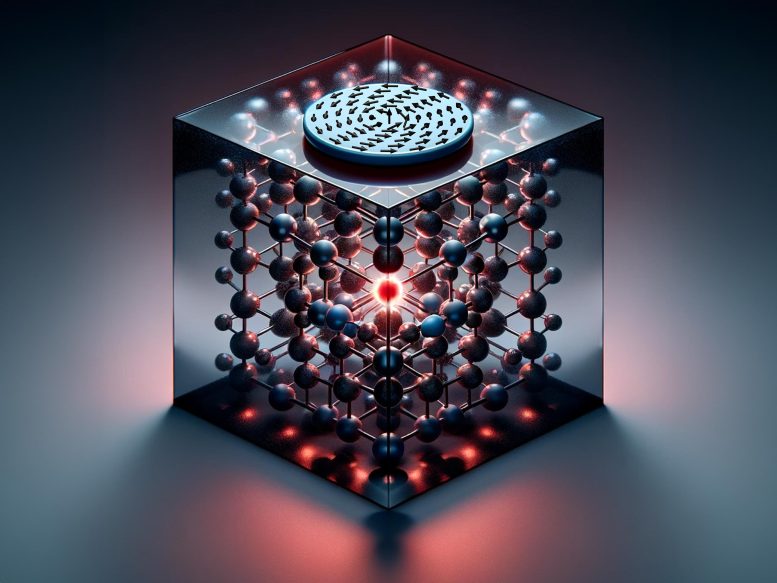
Researchers at HZDR managed to generate wave-like excitations in a magnetic disk – so-called magnons – to specifically manipulate atomic-sized qubits in silicon carbide. This could open new possibilities for the transduction of information within quantum networks. Credit: HZDR / Mauricio Bejarano
Researchers at HZDR have developed a new method to transduce quantum information using magnons, offering a promising approach to overcoming the challenges in quantum computing, particularly in enhancing qubit stability and communication efficiency.
Quantum computers promise to tackle some of the most challenging problems facing humanity today. While much attention has been directed towards the computation of quantum information, the transduction of information within quantum networks is equally crucial in materializing the potential of this new technology.
Addressing this need, a research team at the Helmholtz-Zentrum Dresden-Rossendorf (HZDR) is now introducing a new approach for transducing quantum information: the team has manipulated quantum bits, so-called qubits, by harnessing the magnetic field of magnons – wave-like excitations in a magnetic material – that occur within microscopic magnetic disks. The researchers presented their results in the journal Science Advances.
Challenges in Quantum Technology
The construction of a programmable, universal quantum computer stands as one of the most challenging engineering and scientific endeavors of our time. The realization of such a computer holds great potential for diverse industry fields such as logistics, finance, and pharmaceutics. However, the construction of a practical quantum computer has been hindered by the intrinsic fragility of how the information is stored and processed in this technology. Quantum information is encoded in qubits, which are extremely susceptible to the noise in their environment. Tiny thermal fluctuations, a fraction of a degree, could entirely disrupt the computation.
This has prompted researchers to distribute the functionalities of quantum computers among distinct separate building blocks, in an effort to reduce error rates, and harness complementary advantages from their constituents. “However, this poses the problem of transferring the quantum information between the modules in a way that the information doesn’t go missing,” says HZDR researcher Mauricio Bejarano, first author of the publication. “Our research lies precisely in this specific niche, transducing communication between distinct quantum modules.”
Advanced Quantum Communication
The currently established method to transfer quantum information and addressing qubits is through microwave antennas. This is the approach used by Google and IBM in their superconducting chips, the technological platform standing at the forefront in this quantum race. “We, on the other hand, address the qubits with magnons,” says HZDR physicist Helmut Schultheiß, who supervised the work
“These can be thought of as magnetic excitation waves that pass through a magnetic material. The advantage here is that the wavelength of magnons lies in the micrometer range and is significantly shorter than the centimeter waves of conventional microwave technology. Consequently, the microwave footprint of magnons costs less space in the chip.”
Sophisticated Frequency Divider
The HZDR group investigated the interaction of magnons and qubits formed by vacancies of silicon atoms in the crystal structure of silicon carbide, a material commonly used in high-power electronics. Such types of qubits are typically called spin qubits, given the quantum information is encoded in the spin state of the vacancy. But how can magnons be utilized to control these types of qubits?
“Typically, magnons are generated with microwave antennas. This poses the problem that it is very difficult to separate the microwave drive coming from the antenna from the one coming from the magnons,” explains Bejarano.
To isolate the microwaves from the magnons, the HZDR team used an exotic magnetic phenomena observable in microscopic magnetic disks of a nickel-iron alloy. “Due to a nonlinear process, some magnons inside the disk possess a much lower frequency than the driving frequency of the antenna. We manipulate qubits only with these lower frequency magnons.” The research team emphasizes they did not perform any quantum calculations yet. However, they showed that it is fundamentally feasible to address qubits exclusively with magnons.
Leveraging Magnon Power
“To date, the quantum engineering community has not yet realized that magnons can be used to control qubits,” stresses Schultheiß. “But our experiments demonstrate that these magnetic waves could indeed be useful.” In order to further develop their approach, the team is already preparing for their future plans: they want to try to control several closely spaced individual qubits in such a way that magnons mediate their entanglement process – a prerequisite for performing quantum computations.
Their vision is that, in the long term, magnons could be excited by direct electrical currents with such precision that they specifically and exclusively address a single qubit in an array of qubits. This would make it possible to use magnons as a programmable quantum bus to address qubits in an extremely effective manner. While there is plenty of work ahead, the group’s research highlights that combining magnonic systems with quantum technologies could provide useful insights for the development of a practical quantum computer in the future.
Reference: “Parametric magnon transduction to spin qubits” by Mauricio Bejarano, Francisco J. T. Goncalves, Toni Hache, Michael Hollenbach, Christopher Heins, Tobias Hula, Lukas Körber, Jakob Heinze, Yonder Berencén, Manfred Helm, Jürgen Fassbender, Georgy V. Astakhov and Helmut Schultheiss, 20 March 2024, Science Advances.
DOI: 10.1126/sciadv.adi2042








Have read about experiments with graphene that when five layers are stacked and stepped down that a fractionating of a electron is observed, thinking in the terms of coding photons could this fractioning be used to code the qubit for distinction between other qubits to transfer the information utilizing the magons microwave fraction. fractioning would open a large amount of code variations
To date, the quantum engineering community has not yet realized that magnons can be used to control qubits. Very good, there are many ways to manipulate qubits.
According to topological vortex gravitational field theory, the spin of topological vortices is the most fundamental qubits in the physical world, the simplest multiple states are the left and right rotation of the vortex, and the simplest multiple places are the front and back of the vortex. All observable movements in the physical world are inseparable from the interaction of topological vortices, including human observational behavior itself and quantum gravity.
The universe does not do algebra, formula or fraction. The universe is geometrythe, and is the superposition, deflection, and twisting of geometric shapes.
Today, we have already entered the era of the internet. With the help of artificial intelligence and big data, discussions on scientific knowledge have become open and transparent. However, a group of editors of so-called academic journals (such as Physical Review Letters, Nature, Science, etc.) are self-righteous and mystifying themselves. They only care about their own so-called sufficiently high priority rating, general significance, discipline, novelty, etc., and do not care about what science and pseudoscience are.
Science and pseudoscience are not determined by a publication, an organization or a person, nor by you or me, but by mathematics the final say. Physical models must be based on mathematics or mathematical models in order to be scientific, convincing, and in accordance with natural laws.
The origin of geometry lies in the concerns of everyday life. The branch of geometry (mathematics) known as topology has become a cornerstone of modern physics. Topological vortex and antivortex are two bidirectional coupled continuous chaotic systems. They exhibit parity conservation, charge conjugation, and time reversal symmetry. The synchronization effect is extremely important in their interactions. The synchronization effect of the superposition, deflection, and twisting of multiple or countless topological vortices will make spacetime motion more complex. To understand this complex world, physics should respect the authenticity of topological vortex in low dimensional spacetime, rather than simply relying on a few formulas, numbers, or imagined particles.
Spin is a natural property of topological vortices. Spin is synchronized with energy, spin is synchronized with gravitation, spin is synchronized with time, spin is synchronized with evolution. The perpetually swirling topological vortices defy traditional physics’ expectations. One physical properties of topological vortices is them to spontaneously begin to change periodically in time, even though the system does not experience corresponding periodic interference. Therefore, in the interaction of topological vortices, time is both absolute and relative,and physics often requires treating space and time at the same level.
Low-dimensional spacetime matter is the foundation of high-dimensional spacetime matter. Low-dimensional spacetime matter (such as topological vortex) can form new material structures and derive more complex physical properties via interactions and self-organization. It is extremely wrong and irresponsible to imagine low dimensional spacetime matter using high-dimensional spacetime matter,such as a cat in quantum mechanics.
Science must follow mathematical rules. For example, the Standard Model (SM) is considered to be one of the most significant achievements of physics in the 20th century. However, the magnetic moment of μ particle is larger than expected, revealed by a g-2 experiment at Fermilab, suggests that the established theory (such as SM) of fundamental particles is incomplete. Furthermore, the SM omitting gravitation, it not involved the time problem and when the particle movement starts. Mathematics is the foundation of science. Physics must respect the scientific nature of mathematics and mathematical models. The SM must be based on mathematical models in order to be scientific, convincing, and in line with natural laws.
I hope researchers are not fooled by the pseudoscientific theories of the Physical Review Letters (PRL), and hope more people dare to stand up and fight against rampant pseudoscience.
The so-called academic journals (such as Physical Review Letters, Nature, Science, etc.) firmly believe that two high-dimensional spacetime objects (such as two sets of cobalt-60) rotating in opposite directions can be transformed into two objects that mirror each other, is a typical case of pseudoscience rampant.
If researchers are really interested in Science and Physics, you can browse https://zhuanlan.zhihu.com/p/643404671 and https://zhuanlan.zhihu.com/p/595280873.
The Physical Review Letters (PRL) is the most evil, ugly, and dirty publication in the history of science. Nature and Science have been influenced by Physical Review Letters (PRL) and are even more notorious. The behavior of these pseudo-academic publications has seriously hindered the progress and development of human society in science and technology.
I am well aware that my relentless repetition can make some people unhappy, but in the fight against rampant pseudoscience, that’s all I can do.
Will it improve my gaming?